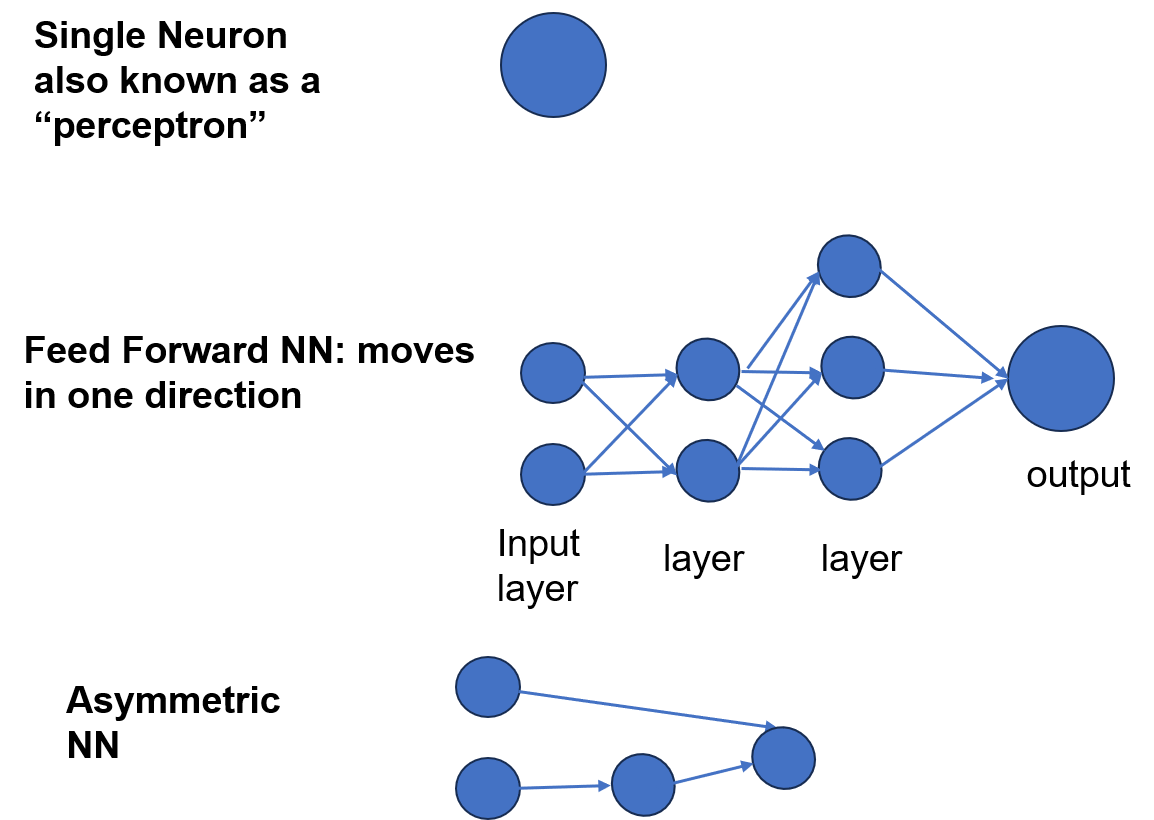Toxic Algorithms: Neural Networks and the "Sexed Brain"
Why Neural Networks are popular in AI.

Efficient and nuanced analysis of large datasets is a challenge in most scientific fields. I regularly deal with the output from thousands of DNA sequences. It would be literally impossible for any human to make any sense of this without some sort of computer program. Furthermore, basic statistics, like t-tests or linear regression, typically only examine one outcome variable at a time. This is highly inefficient if we are trying to analyze the relationships between different variables.
We need computational analysis that can sort, classify, and parse out dozens of different relationships and connections in a dataset. Non-generative AI can use algorithms to sort, classify, and make predictions from large datasets.
Neural Networks (NNs), for better or for worse, are one of THE most popular algorithms used in both generative and non-generative AI. NNs consist of numerous interconnected nodes (networks). Multiple networks can be interconnected (layers). NNs were inspired by how neurons supposedly operate in the human brain. Based on sensory input, they “fire” signals to other neurons in rapid, intricate patterns that can result in bodily action.
The most common NN is a “feed-forward” neural network in which a trigger/stimulus is provided to the network and is unidirectionally transferred and propagated through the network to achieve an outcome. This largely relies on a thought process known as “bottom-up” processing, in which the NN can generalize outcomes based on the data it’s fed. Inductive reasoning is a core aspect of the scientific method, which values “masculine-coded” traits such as objectivity, logic, and rationalism.
NNs are a reflection of society’s pre-existing biases and have become an engine that reproduces and magnifies these biases.
NNs Originated from Theories of Brain Science
Psychologist Frank Rosenblatt was an early pioneer of the deployment of artificial NNs. Rosenblatt was motivated to develop innovative computer science methods to analyze large datasets from psychological experiments. Rosenblatt built a custom electronic computer for his 1956 PhD dissertation to analyze psychological data. His research was motivated by three questions:
How is information about the physical world sensed by the biological system?
In what form is information stored and retrieved?
How does remembered information influence recognition and behavior?
Theories of human brain science inspired the development of NNs. Rosenblatt was heavily influenced by his classes on brain science. Moreover, he had previously researched schizophrenia.
In later years, one of his mentees, George Nagy, argued that Rosenblatt’s NN had met these goals of effectively modeling human brain function. The basic concepts of “training”, “reinforcement learning”, and “plasticity” were encapsulated in Rosenblatt’s 1962 book Principles of Neurodynamics: Perceptrons and the Theory of Brain Mechanisms.
The original system of connected cells is capable of a certain amount of plasticity; after a period of neural activity, the probability that a stimulus applied to one set of cells will cause a response in some other set is likely to change, due to some relatively long-lasting changes in the neurons themselves.
The application of positive and/or negative reinforcement (or stimuli that serve this function) may facilitate or hinder whatever formation of connections is currently in progress.
The structure of the system, as well as the ecology of the stimulus-environment, will affect, and will largely determine, the classes of “things” into which the perceptual world is divided.
At the time, racism, ableism, and sexism saturated the fields of neuroscience, biology, and psychology; this does not bode well for the 1950s-era NN as a “universal” model of the human brain.

NN as a Human Brain Model
Using artificial NNs to model human brain function is an area of cognitive science known as “Connectionism.” Connectionism implies that the number and strength of connections between neurons can represent cognitive function. This is a rigid interpretation of brain function and learning, but was relatively accepted as a plausible and even popular theory for decades.
Meanwhile, developments in artificial NNs improved their alleged resemblance to brain function. This 1986 paper by David E. Rumelhart, Geoffrey E. Hinton & Ronald J. Williams on backpropagation was a key turning point in NN development and its application in computer science.
Backpropagation can “mimic” the concepts of “plasticity” in the brain, i.e., that connections between neurons “strengthen” over time, and this helps us to “learn”. The addition of “layers” into NNs, first proposed in 1975, allowed for “deep learning” in the system. With improvements in computational storage spaces and processing systems, NNs were “popular” by the 1980s and 1990s.
As NNs and computer science evolved, so did neuroscience.
NN Development was Influenced by Flawed Theories on “Sexed Brains”
A 1980 paper reviewed brain science developments from the 1940s-1970s and reveals the field’s belief in the fundamental differences among female brains (“symmetric”-greater connectivity between hemispheres) and male brains (“asymmetric”).
“Asymmetric brains” were defined as having stronger connectivity within each hemisphere, facilitating efficient systems for coordinated action by bridging perception and action.
This is also called “bottom-up” information processing. “Bottom-up” processing connotes “masculine-coded” traits such as objectivity, logic, and rationalism, core aspects of the scientific method.
Supposedly, women, with their “symmetric” brain, lean into “top-down processing” that uses prior knowledge/perceptions to process information.
A 1980 paper developed a NN to resemble the so-called “asymmetric brain”. “Asymmetric” neural networks, which had uneven weights and inputs, were developed and refined over the following decades.
Asymmetric neural networks have gained popularity in deep learning and AI applications. However, asymmetry in NNs is more likely to propagate bias than symmetry.
“Top-down” NN had minimal development even by 2005, and this paper called for
“Future neural network models must incorporate the top-down alteration of cortical function by expectation or perceptual tasks. These newly found dynamic processes are challenging earlier views of static and feedforward processing of sensory information.”
NNs were designed to resemble flawed sexist theories about brain development, which resulted in an increased risk of propagating bias.
Other limitations of the NN model for the brain are that NNs have really only been tested on visual or auditory stimulation, and can be oversimplistic. A 1995 feminist critique of AI and its use of Neural Networks argues that connectivism is purely trying to imitate mechanical rather than emotional functions in the brain.
“the epistemology of AI is predicated on traditional rationalist epistemology. This makes the knower at once invisible and universal and excludes alternative points of view where feminist epistemlogy emphasizes the standpoint of the observer which can include race and class as well as gender and also the role of the body in knowledge production. In this way AI systems, by the process of reifying knowledge, can be used to exclude the other, the different and inevitably women.
Secondly the emphasis on propositional knowledge in AI systems makes material and explicit one form of knowledge at the expense of common sense and skills or knowing how, which, it is argued, is the form of much of traditional women’s knowledge.
The body has to be brought into AI. The force of such arguments suggests that it is not a question of deliberate exclusion of women’s knowledge from such systems, rather that in many cases it would not be possible to capture the knowledge, so the notion of a system based on that knowledge becomes meaningless. […]
The way forward for an AI informed by feminism can involve not only tackling feminist projects with traditional AI technology but also more ambitious and speculative attempts to become involved in the newer areas of AI which are consciously addressing the need to involve the body in the representation of knowledge.”
The arguments here are that NN models cannot capture or replicate advanced cognitive functions, or even “common sense/emotions,” which are stereotypically “women’s” domains of knowledge. A 2022 article is even more vehement about the dangers and oversimplification of “sexing” brains.
“An account of sex differences in brain and behaviour is essentialist to the extent that it assumes (whether explicitly or implicitly) that differences of brain structure and function between men and women on the group level warrant pronouncements on what “male brains” and “female brains” respectively are like, considered as kinds of brains.
When the terms “male brain” and “female brain” are thus used to denote kinds of brains, it is implied that each such kind has an essence, in the sense of possessing a set of traits or properties that are individually necessary and jointly sufficient to mark it off from its counterpart.
The Penn Medicine study of the sex-differentiated human connectome exemplifies this sort of reasoning. Based on the finding that, on average, stronger connectivity within each hemisphere and stronger modularity and transitivity predominated among males whereas more females showed stronger interhemispheric connectivity and less modularized and transitive networks, and correlating these findings with results on a battery of cognitive tasks in a companion study of the same group of subjects, the authors conclude that “male brains are structured to facilitate connectivity between perception and coordinated action, whereas female brains are designed to facilitate communication between analytical and intuitive processing tasks” (Ingalhalikar et al., Citation2014, p. 823).
It is as if the brain of a woman does not equip her to adjust her movements to the sensory feedback she receives from the environment, making her dependent on her male companion to perform the tasks that require such coordinated action—as if natural selection would not have discarded such a clunky type of brain long ago.
However, as neurofeminist Daphna Joel and colleagues have shown, it doesn’t make sense to think of brains in this essentialist way: Although there are differences of brain features and behaviour between men and women on the group level, at the individual level—in the overwhelming majority of cases—brains are mosaics of both male- and female-typical traits.
For instance, someone with a female-typical connectivity strength in one brain region may well have male-typical connectivity strength in some other brain region.” (cf. Joel et al., Citation2015)
Male and female type brains are largely very simplistic, overstated, and elevated in neuroscience, and fail to reveal the true complexities of the marvelous human brain.
NNs are a Poor Imitation of the Brain, but are Being Used to Create Humanoid Programs
Researchers claimed that NNs “mimicked” the same patterns that light up in animal brains. This work was disproved though by MIT researchers. Previously, NNs used to model brain function were heavily trained with “biologically implausible” data to replicate brain function.
In an analysis of more than 11,000 neural networks that were trained to simulate the function of grid cells — key components of the brain’s navigation system — the researchers found that neural networks only produced grid-cell-like activity when they were given very specific constraints that are not found in biological systems. […]
“What this suggests is that in order to obtain a result with grid cells, the researchers training the models needed to bake in those results with specific, biologically implausible implementation choices,” says Rylan Schaeffer, a former senior research associate at MIT. […]
Without those constraints, the MIT team found that very few neural networks generated grid-cell-like activity, suggesting that these models do not necessarily generate useful predictions of how the brain works.
Overall, NNs have been developed to imitate stereotypical characterizations of male cognition with emphasis on bottom-up processing. Popularized by detective stories like Sherlock Holmes, bottom-up processing is often coded as the more “scientific” form of thinking.
In fact, AI has been compared to whether it could “compete” with real and fictional male geniuses:
From Baker Street to Neural Networks: Could AI Beat Sherlock Holmes at His Own Game?
Could Artificial Intelligence Solve The Problems Einstein Couldn't?).
NNs have been integrated into many interfaces, including YouTube, and OpenAI. They may be more likely to perpetuate bias, promote problematic content, and encourage addictive behaviors, which I will explore in a future post.
The incorporation of NNs into AI applications carries on a long legacy of anthropomorphizing computers to imitate human behavior.
NNs continue to be improved so AI can become a “human collaborator.”
Author Spotlight
We’re so grateful to
for allowing us to share their story here on Code Like A Girl. You can find their original post linked below.If you enjoyed this piece, we encourage you to visit their publication and subscribe to support their work!
Join Code Like a Girl on Substack
We publish 2–3 times a week, bringing you:
Technical deep-dives and tutorials from women and non-binary technologists
Personal stories of resilience, bias, breakthroughs, and growth in tech
Actionable insights on leadership, equity, and the future of work
Since 2016, Code Like a Girl has amplified over 1,000 writers and built a thriving global community of readers. What makes this space different is that you’re not just reading stories, you’re joining a community of women in tech who are navigating the same challenges, asking the same questions, and celebrating the same wins.
Subscribe for free to get our stories, or become a paid subscriber to directly support this work and help us continue amplifying the voices of women and non-binary folks in tech. Paid subscriptions help us cover the costs of running Code Like A Girl.






The historical thread from Rosenblatt's 1956 schizophrenia research to today's YouTube algorithms is damning, but the critique conflates legitimate points about embedded bias with questionable claims. The asymmetric NN architecture propagating bias more than symmetric ones is verifiable. The MIT study disproving brain mimicry is solid evidence that NNs are marketing bullshit masquerading as neuroscience.
But the argument that NNs exclude "women's knowledge" by favoring propositional over experiential knowledge stretches thin. This was not a gender issue, it's a limitation of all formal systems trying to capture tacit knowledge. The 1995 claim that "the body has to be brought into AI" sounds poetic but offers no actionable framework.
The real toxicity isn't that NNs model "masculine" thinking. It is that they model 1950s pseudoscience about what masculine thinking supposedly is, then reproduce those errors at scale. The architecture doesn't need to be "feminized," it needs to stop pretending it's modeling human cognition at all.